-
solutinos
-
Hire
Frontend Developer
Backend Developer
-
NodeJS Developer
-
Java Developer
-
Django Developer
-
Spring Boot Developer
-
Python Developer
-
Golang Developer
-
Ruby on Rails Developer
-
Laravel Developer
-
.NET Developer
Technology
-
Flutter Developer
-
React Native Developer
-
Xamarin Developer
-
Kotlin Developer
-
Cross-Platform Developer
-
Swift Developer
-
MongoDB Developer
-
C Developer
-
Smart Contract Developers
Cloud
-
-
Services
Mobile Development
Web Development
- Work
-
Multi Services App
-
Food Delivery App
-
Grocery Delivery App
-
Taxi Cab Booking App
-
Multi Services App
-
OTT Platform APP
-
Social Media APP
-
Freelance Service App
-
Car Rental App
-
Medicine Delivery App
-
Liquor Delivery App
-
Sports Betting App
-
Online Coupon App
-
eLearning App
-
Logistics & Transportation App
-
Courier Delivery App
-
On-Demand Real Estate App
-
E-Wallet APP
-
Online Dating App
-
Handyman Services App
-
-
Process
-
Company
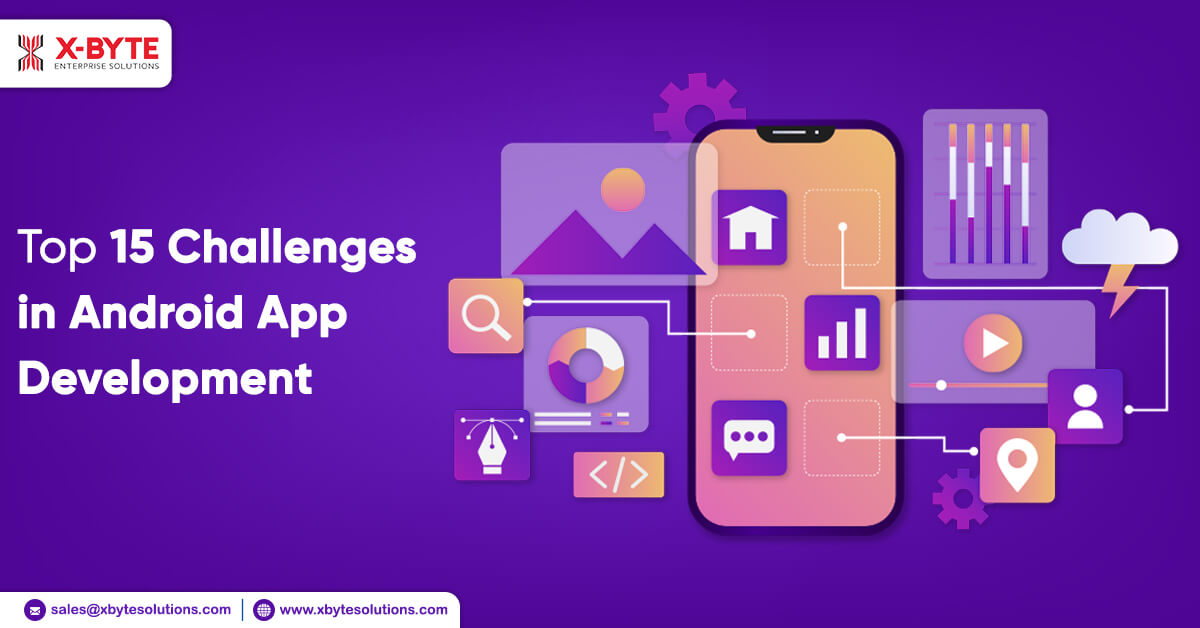
Quick Summary : Android developers at X-byte share their experience with the top challenges faced in Android App Development and also suggest solutions to address them. We have also covered pre-development and post-development challenges of Android development in the later part of the article.
Android is the most popular mobile platform with the highest user base and devices. For businesses who want to list their app on the Google Play Store, Android app development is a boon. It offers the ability to reach millions who can be a potential customer for their app. But the same is a challenge for Android developers who will have to work through the complex web of thousands of device types, screen sizes, resolutions, hardware configurations, and tools to develop an Android app.
Unlike iOS app development, which has limited device configurations Android app platform stretches its territory to more diverse software and hardware fragmentation. Knowing exactly what these challenges are and what they stem from is the first step to addressing the difficulties in Android app development.
Let us dwell deep into the top challenges in Android app development.
1. Technology Stack Selection
Programming language
Android app development can be credited for its generosity in providing multiple options for programming languages. You have a great basket of choices for programming languages ranging from Java, Kotlin, C++, Python, and so on. Businesses can hire Kotlin Developers to enhance usability and market reach. However, this abundance of choice can confuse developers.
Solution
Choose a language based on your app’s purpose and features. For instance, if you are developing an algo trading app, security and performance are the key features.
Algo traders cannot afford glitches or crashes during peak trading times. In this case, choosing a language that offers immense security and stability (like Java) will be a preferred choice.
However, if you are developing a gaming app that requires 3D rendering or animations, then you will need a language (like C++) that is capable of high-performance tasks.
Framework
Today's Android developers are highly dependent on frameworks for prebuilt tools, code extensions, tool libraries, and development packages. These frameworks ease and expedite the development process by providing coders with reusable codes and design components.
However, the life of an Android developer would have been easy if only one or two mobile app development frameworks existed. But is it? No.
Many frameworks are available and that too with different frameworks for different types of apps (Native apps, web apps, hybrid apps).
Choosing the right one can be an extremely breathtaking task, especially when each framework looks lucrative with its extensive feature sets and capabilities.
Solution
Check your requirements against the framework's functional features. For example, suppose you are building a gaming app for the Android platform. In that case, a robust mobile app framework like Solar 2D (formerly Corona SDK) can be a great choice owing to its ease of iterations designed for high-end gaming apps” says a Senior Android App Developer at Xbyte.
The idea is to get the best development tools and libraries for a particular app.
2. Ensuring App’s Compatibility with Various Android Software Versions
Software Fragmentation issues
From its humble beginnings with the first launch of an Android version in 2008 (Android 1.0) to its latest Android 15 (Vanilla Ice Cream version), for which a developer preview was released in Feb 2024, Android has seen over 12 versions.
Now while most Android devices that work today have moved to higher versions, there are some users still having smartphones with older versions of Android. This means the developer has to make sure the app is compatible with as many versions as possible realistically.
However, this is not an easy job to test so many features on different Android versions. There may be cases where some toolkits or libraries that the developers are using currently are incompatible with some earlier Android versions.
Solution
Use Emulator. Android Studio provides an emulator that lets developers simulate multiple devices and versions of Android for testing purposes. The emulator virtually runs the app on multiple devices to check version/device compatibility.
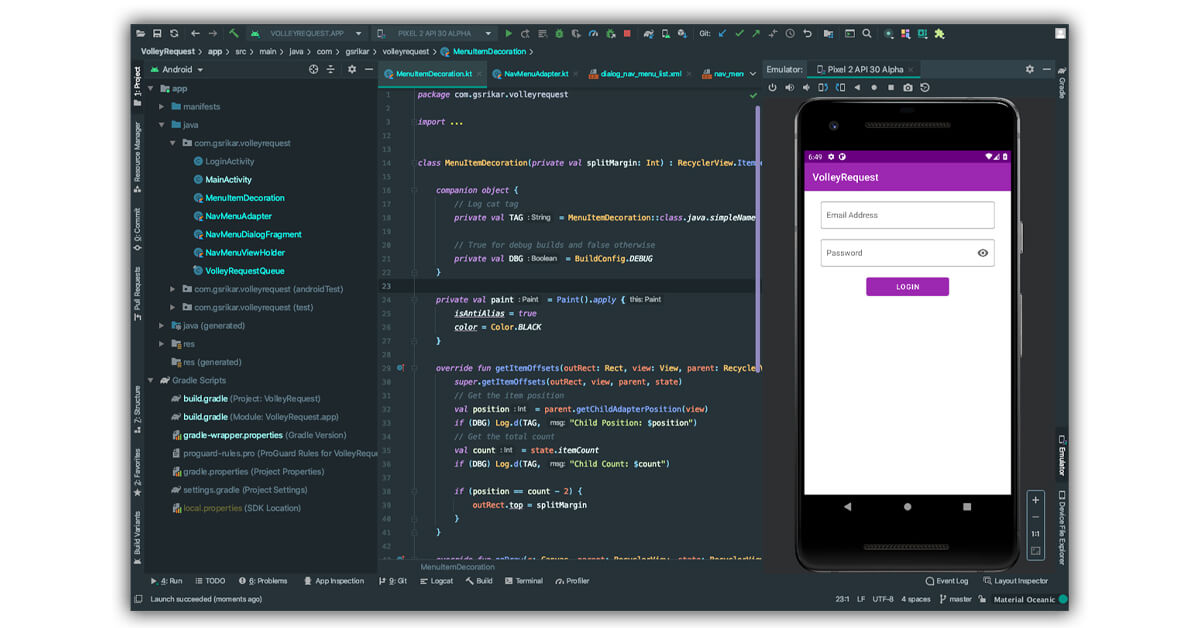
3. Testing the App’s Code against Diverse Device Configurations and Screen Sizes
Device fragmentation in the Android world is incomparable to the iOS ecosystem. While iOS has few device variations (on devices launched by Apple), Android is the go-to OS for almost 70% of other device manufacturers. Android’s open-source nature is a bliss for mobile device manufacturers but a nightmare for developers who now need to test the code for hundreds of device variations.
Solution
Same as for the above point. Use Android Studio’s Emulator.

Boost the User Experience with Feature-rich and Optimized Android Apps by Hiring Android Developers from Our Pool of Resources.
Get a Free Quote Get a Free Quote4. Debugging the App Code and Resolving Code Errors
Developers need to identify errors and debug apps to keep them issue-free. However, it is not as easy as it might appear. They need to analyze app behavior, performance, and memory usage. They also need to check variables and code errors. Testing and debugging on so many Android device configurations is exhausting for the developers.
Solution
Android developers can use Android Studio’s tools, Emulator device testing, and also leave notes in the code to track using using Android log. Think of logging as a way for developers to leave behind notes in their code. They can use a tool called Android Log to jot down information, warnings, and errors. Other methods for making your app code error-free include handling errors with try-catch blocks for user-friendly error messages or getting fresh perspectives from peers, third-party libraries, and documentation to improve code quality.
5. Designing an Intuitive User Interface
Four aspects of UI/UX that need undivided attention are Utility, Usability, Desirability, and Brand Experience. This is a particular part where developers need to think only from a user’s perspective. Whether the app is useful for the user? Whether the user can run and enjoy the app easily? Does the app look aesthetically pleasing and whether the overall experience is exhilarating or not (to the point that makes the user feel good about the brand experience while using the app)?
Solution
Follow the guidelines of UI/UX and the best practices like the ones laid down by Google or Material and you can also hire UI/UX developers for intrinsic designs and smooth user interface. These guidelines provide specifics for the theme, style, design principles quality, etc. These guidelines will help you project a great visual experience with UI layers.
6. Minimizing the Learning Curve for End Users
The complex nature of app development in itself makes it difficult to create apps that are intuitive for all users. Plus when businesses want their app to be extremely feature-rich, the challenge amplifies for the developer.
Solution
Keeping the app simple to use (decluttering or removing the noise) and delivering a relevant experience (signal, as Google calls it) is the key to minimizing the learning curve for end users. This can be done by keeping navigation self-evident. Another thumb rule is to design for interruptions. For instance, Twitter’s notification screen doesn’t automatically get updated and any distracted user who wants to reengage with the app can see notifications at the top of the screen.
7. Balancing Functional Aspects (features and usability) with Aesthetics
-with-Aesthetics.jpg)
Balancing functional aspects (accessibility, adaptiveness, task efficiency, and responsiveness) with aesthetics (colors, typography, whitespace, animation, imagery, and layouts) is a dilemma faced by inexperienced and even experienced mobile app developers.
Choosing the design approach is a challenging aspect of Android app development. Apps like TikTok, Instagram, and Facebook are credited for their functional interface.
These apps have removed cognitive load and keep the grid uncluttered. However, even in doing so, they are not compromising with the aesthetics.
Solution
While it is advisable to keep a balance between functional and aesthetic elements in mobile app development, the choice should be strictly based on the industry for which you are coding. For instance, ecommerce companies focus on visual appeal while healthcare apps should be more focused on functionality.
Get Access to Expert Android App Developers Who have Expertise in Creating Feature-rich Solutions by Enhancing User Experience.
8. Ensuring Speed and Performance of the App
Slow loading time is the main performance issue in Android apps. However, this is the red line that users will draw to leave an app, forever. No one likes slow opening apps or poor navigation between screens.
Poorly written codes, third-party APIs that slow down networks, and poorly bundled resources are prime culprits for slowing down the speed of the app.
High latency issues can make an app feel unresponsive and sluggish. These issues can arise due to various factors such as inefficient coding, large file sizes, and inadequate network connectivity.
Solutions
Writing clean and concise code, using appropriate data structures, and optimizing algorithms. developers can make use of profiling tools to identify bottlenecks and optimize resource usage. Such measures will keep the server data access time for the app to less than 1 sec and ensure a faster loading time and no latency.
9. Mitigating Battery Drain Issues Associated with App
If an app is draining a lot of battery, the optimization apps in Android devices will flag it as (draining too much battery). It is the responsibility of an Android developer to make the app battery-efficient.
Not only will it greatly improve the user experience, but it can also lead to a flood of positive app reviews. Imagine the joy on your users' faces when they realize that your app doesn't drain their battery like other apps do.
Conversely, overheating issues caused due to your app will make users uninstall your app.
Solution
While making the app, Android developers must choose battery-friendly libraries.
“Techniques like image compression, HTTP caching, and location optimization can help save battery life”, says Android Developer at X-Byte.
Other solutions are using code shrinkage, adding dark mode, avoiding using wake locks, and minimizing the database (to reduce the load on the CPU).
10. Addressing Third-party API Integration Challenges
Connecting with third-party platforms is a challenge for Android developers. Why? Because there are integration issues.
Android developers have to integrate with third-party APIs to increase the features and functions of their apps. Application programming interfaces (APIs) are like shortcuts for developers. They help them do advanced stuff in their Android apps without starting from scratch.
Things like user logins or keeping information safe with encryption would take a long time to code without APIs.
But there's a tricky part with Android: it's got lots of different versions, and not all APIs work on every version. This means developers have to be careful when using third-party APIs because they might not work on all Android phones.
The big problem comes when an API uses a part of Android that's old-fashioned or not recommended anymore. It's like trying to use an old tool that doesn't fit with the new ones. So, developers need to keep an eye on each new version of Android that comes out and update their APIs if needed. But this updating process is boring and takes a lot of time.
Solution
Creating interfaces that work across all Android devices using API development tools.
11. Eliminating Security Issues
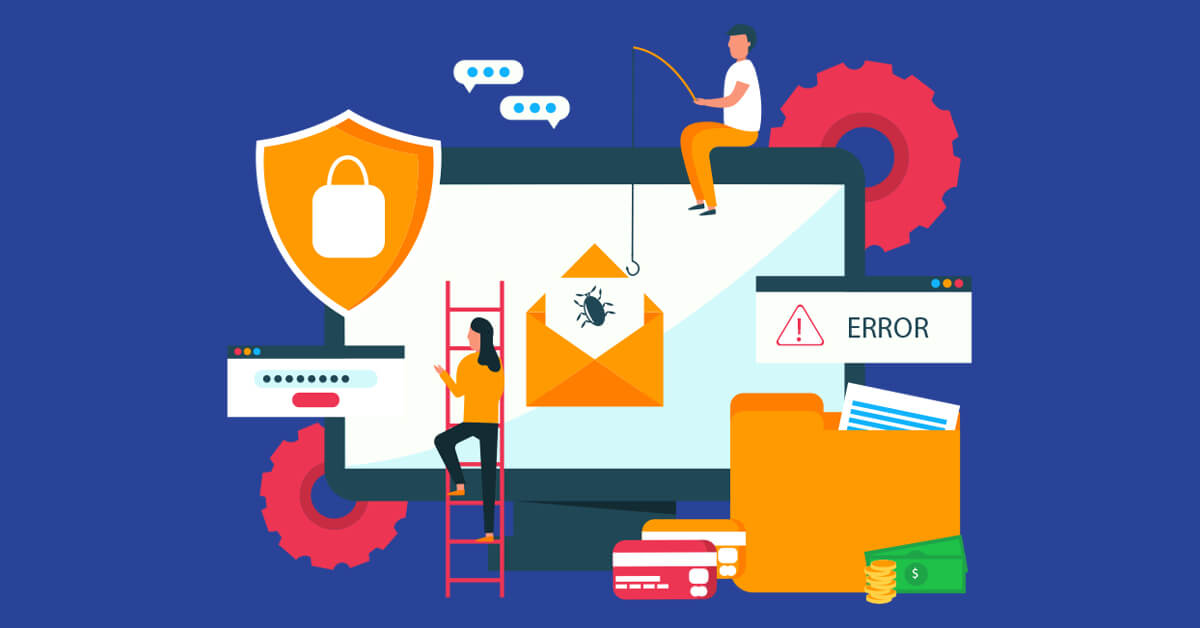
Making apps secure is always a big deal, but with Android, it's even trickier because Android is open-source. That means anyone can look at the code and find ways to break in. One reason it's a big deal is because phone makers often change Android to fit their devices. But when they do that, they might accidentally make it less secure.
There have been some big problems with security on Android devices in the past, like bugs and breaches with names like mRST, Stagefright, FakeID, and others. These issues affected a lot of Android phones. While vigilante projects like Google Project Zero, keep sharing the vulnerability reports for Android devices, sometimes it is too late before it is detected.
And since the Android code is out there for anyone to see, hackers have an easier time finding weaknesses.
Solution
App developers need to make their apps super secure using really strong encryption to scramble sensitive info when it's sent or stored. They also need to make sure only the right people can access the app by using secure login methods. Another important thing is to keep everything up to date. Just like how you update your phone's software, developers need to update the tools they use to make apps.
12. Ensuring Intellectual Property (IP)/Patent Compliance
Patents are a double-edged sword. If your app becomes popular, there's a chance someone might copy it. But it can go the other way too – you might accidentally make your app features, UI, and other elements too similar to someone else's. If that happens, the other app might take legal action against you for copying their intellectual property (if they have taken copyrights or patents). it could also mean the owners of the app have to pay a lot of money in fines and legal fees.
In 2020, Ubisoft Entertainment SA sued Apple Inc. and Google LLC for copyright infringement for listing on their app stores a copy of its popular video game “Tom Clancy’s Rainbow Six: Siege.
Solution
To avoid this mess, you should check out what other apps in your category are doing to make sure you're not copying them. And it's really important to understand patent laws so you know how much you can borrow from other apps without getting into trouble. Android developers can read the safety guidelines by Google for app developers.

Leverage Our Expertise with Custom Android App Development Services Tailored to Satisfy Your Business Needs.
Hire Android Developers Hire Android Developers13. Maintaining App Stability (Crash rate >0.1% per session)
The crash rate for Android apps is calculated based on a simple formula: (no. of crashes/number of operational sessions). The ideal crash rate should be less than 0.1% per session and 0.01% (per screen view). Now, the challenge in keeping the crash rate below the desired level is that many device hardware can be incompatible with an Android version, or the user is currently using a mobile that has limited memory and slower processing speed. These issues are sometimes out of the hands of the developer. But when apps keep crashing, users will generally go and post a bad review on the Google Play Store. Ultimately companies will blame the developers.
Solution
If you have considerable app usage and downloads, it is practically impossible to prevent crashes from occurring. However, optimizing and rigorously testing the app for memory utilization, network errors, and bugs can help lower the crash rate to acceptable levels.
14. Storage Capacity Optimization
As an Android techie trying to develop an app, you know multiple issues arise while optimizing memory consumed by the app like memory leaks, memory waste, OOM errors, etc. Also initializing objects can drain memory, especially at expensive places. In Android, there are various methods and approaches for optimizing memory usage in apps.
These techniques aim to minimize the amount of memory consumed by an application, prevent memory leaks, and optimize memory allocation. By implementing these optimizations, the performance and stability of Android apps can be greatly enhanced, resulting in an improved user experience and higher app ratings.
Solution
Utilize different memory management techniques offered by the Android platform, including garbage collection, efficient memory allocation, and caching. By employing these strategies, you can effectively manage and optimize memory usage in your Android applications.
15. Keeping the App Scalable
Businesses demand mobile apps that can handle increasing amounts of data and user traffic without defaulting on performance. As an app grows, it may require more memory, processing power, and network bandwidth. One of the main challenges in keeping an app scalable is anticipating future growth and designing the architecture accordingly. This will require a deep analysis of factors like number of users, the volume of data, and the potential for new features and functionalities. Building a flexible architecture that can handle increased workloads without causing performance bottlenecks or system failures is not that easy.
Solution
Use techniques such as caching frequently accessed data, optimizing algorithms, and implementing efficient data structures. By effectively managing resources, developers can ensure that their app remains responsive and performs well even under high loads. Also ensure a flexible architecture capable of aligning with metrics such as response times, CPU usage, and memory consumption.
Other Challenges
Apart from the above development challenges faced by Android developers, there are pre-development and post-development challenges that they might have to deal with. While many of the pre and post-development challenges are taken care of by project managers, marketers, business research teams, and digital marketers, Android developers also are consulted to solve the below challenges.
Let us see what these challenges are
Pre-Development Challenges
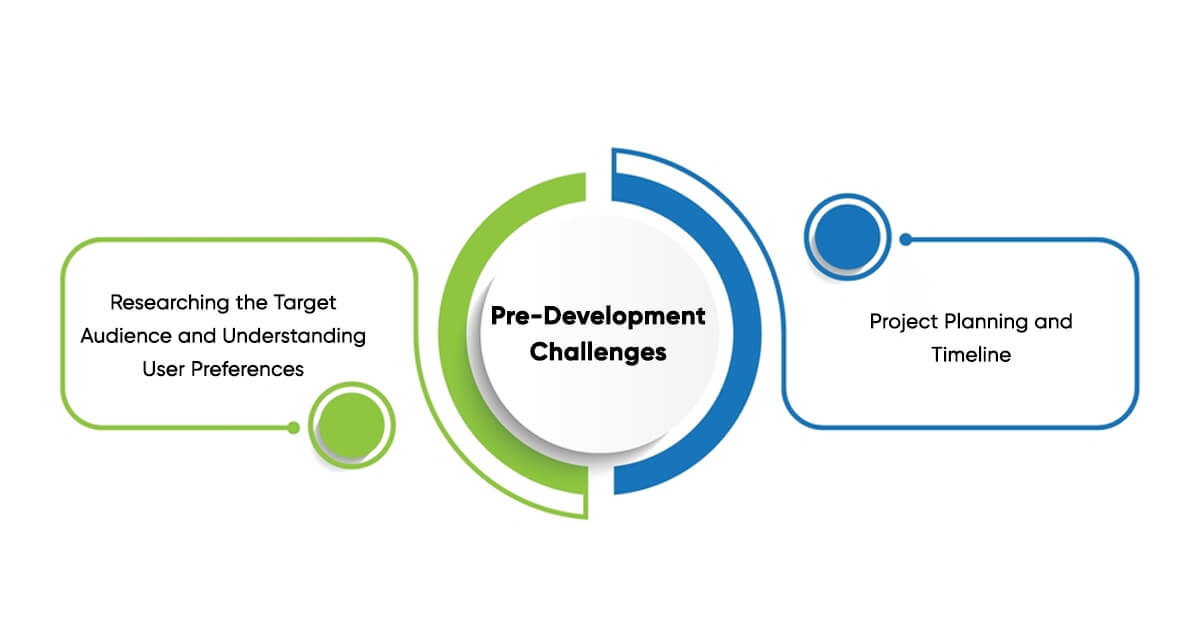
Researching the target audience and Understanding User Preferences
With so many user personas like introverts, extroverts, openness to newer experiences, conservative users, conscious users, skeptical users, etc. it can be difficult for developers to create something that everyone likes. However, the grey area can be reduced by researching the target audience and understanding their preferences.
Understanding user preferences is crucial in pre-Android app development because conducting market research helps ensure the app addresses pain points and meets user requirements. Knowing user preferences also guides intuitive design, leading to higher satisfaction and retention. Plus, Android developers can customize the app and prioritize user-preferred features to go one limit higher than their competitors.
Project Planning and Timeline
The process of developing an Android app involves numerous stages, each with its own challenges and requirements. Idea conception, resource allocation, selecting tools, estimating costs, and determining the project completion timeline are overwhelming for Android developers. However, these parameters are critical for ensuring the successful development and delivery of the app. Despite thorough planning, unexpected challenges and obstacles may arise during the development process. To account for these uncertainties, it's crucial to allocate buffer time in the project timeline. Developers can use project management tools and time planners for better planning during the pre-development stage.
Post-Development Challenges
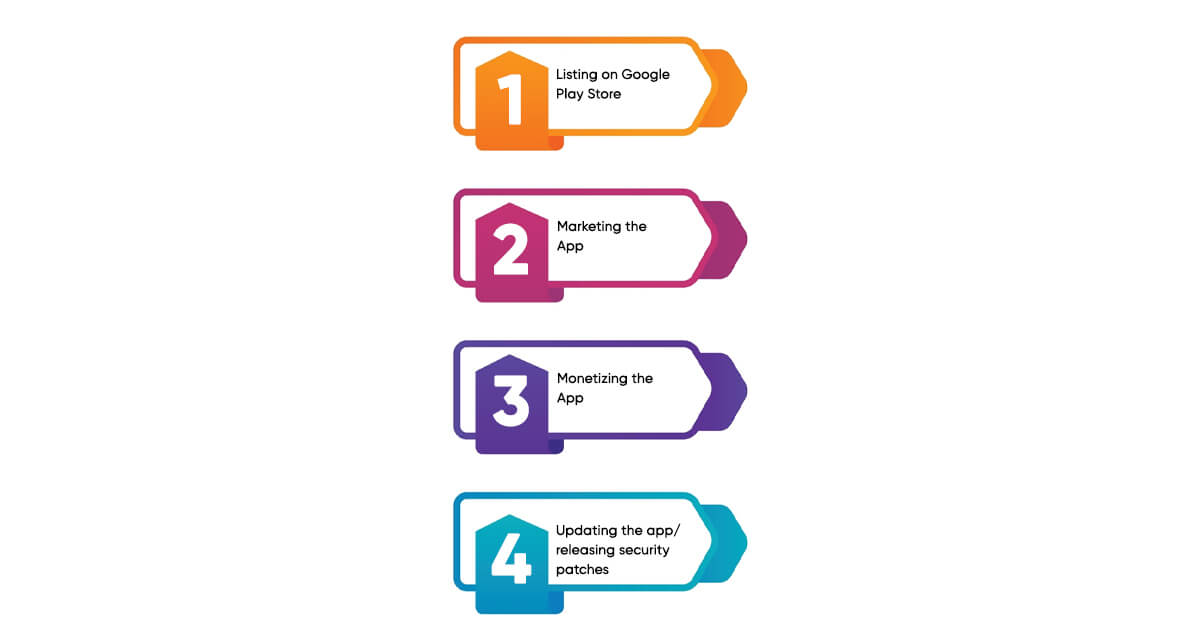
Listing on Google Play Store
Having high-quality and policy-compliant store listings is important for Google Play Store to list your app without rejections, or removals. Deceptive behavior, IP infringement issues, poor descriptions, and use of restricted/inappropriate content are some reasons Google may not list your app. Ensure that your app's title accurately reflects its functionality and content.
Make sure that your app's description provides an accurate portrayal of its functionality and content.
Follow listing advice from the Google Play Store itself:
- You have a maximum of 4,000 characters for a full description.
- For the short description, aim to convey your app or game's message in 80 characters or less.
- Avoid using words or phrases in your app description that may mislead users about its relationship to someone else or another app.
- Refrain from including misleading or irrelevant references to other apps or products.
- Saying that something is the "best" or "#1 rated" or comparing it to another app isn’t permitted.
Marketing the App
Just making a great app isn't enough, people need to know it exists! But with millions of apps on the Play Store, standing out is tough. One way to improve your chances is through app store optimization (ASO). This means using keyword optimization to make sure your app shows up when people search app stores. Writing short and long descriptions as per Google Store’s guidelines will also help. Or, you can try other marketing stuff like paid ads or email marketing to get your app noticed. Either way, making sure your app gets seen by the right people is super important for it to succeed!
Monetizing the App
App development challenges include monetization issues. How to monetize the app and how to balance revenue with user experience. Bad ads affect user experience and brand reputation, scarcity of demand leads to lower ad revenue, fraudulent SDKs cause security risks and revenue loss, and ads disrupt content flow. Balancing monetization with user experience requires non-intrusive ad implementation and exploring alternative revenue streams like in-app purchases.
Ad targeting, personalization, and continuous content improvement are key strategies to combat user churn and maintain engagement. Building strong relationships with reputable ad partners is also essential for successful app monetization.
Updating the app/releasing security patches
Despite developers' best efforts during the development phase, there may remain some security lapses, or as cybersecurity parameters demand, developers may have to keep updating their apps. Cybercriminals continuously discover new vulnerabilities and attack vectors, necessitating proactive monitoring and swift responses to patch any lapses.
Failing to do so could leave users' data and devices vulnerable to exploitation. However, updating apps regularly and releasing security patches pose a significant challenge for Android developers. Releasing updates requires thorough testing which is time-consuming and resource-intensive.
Android developers must prioritize security and keep releasing updates as required.
Bottomline
We hope this article has provided you with a sufficient understanding of how Android app development can be both rewarding and challenging. Android developers can benefit from the solutions that our experts with years of knowledge in the app development field have given along with the mentioned challenges. You can hire python developers with high tech experience in creating solutions ti satisfy your changing busienss needs.
No matter whether you are developing an app for Android or iOS platform, our team can help you out in any challenging phase of the development cycle.
For more details, you can contact senior Android Developers at X-byte Enterprise Solutions.
We will be more than happy to listen to you.
Frequently Asked Questions
-
What is Android app development?
Android app development is the effective process of developing applications for devices and systems running on the Android OS. Android Studio is considered the official integrated development environment (IDE) for developing native Android apps. There are several programming languages available to create optimized mobile apps. Businesses can hire Java developers, which is the most popular and widely utilized Android app development programming language
-
What are the advantages and disadvantages
of Android app development?
Advantages of Developing for Android
Android is considered one of the well-known operating systems used for the app development process. It has several advantages, including:
- Android is an open-source operating system with a large support community.
- Google has provided standards for the design of the Android application, making it simpler for developers to create more user-friendly apps.
- Android applications benefit from fragmentation, which indicates that the program is capable of performing two tasks on a single screen.
- Compared to other platforms, the Android application is simpler to release through the Google Play Store.
Disadvantages of developing for Android
Although fragmentation offers a highly natural approach to user experience, it has certain disadvantages.
- The development team must take some time to adapt to the different screen sizes of smartphones currently on the market and to activate the specific features in the application.
- There might be a wide range of Android smartphones. As a result, testing the application gets harder.
- Depending on the program's features and complexity, the cost may increase as development and testing take longer.
-
Which programming language can be used for Android app
development?
There are several programming languages that can be used to enhance the user experience of Android app development.
List of official programming languages
- Java
- Kotlin
- C++
- C#
- Python
- HTML, CSS, JavaScript
- Dart
- Corona
-
What are the features of Android app
development?
There are several features of Android app development that help in enhancing user experience
- Android operating system is an open-source development that can be customized based on requirements.
- Android facilitates several forms of connectivity, such as GSM, CDMA, Wi-Fi, Bluetooth, and others, for data transmission or phone conversations.
- We can link with other devices to play games or use other apps thanks to wifi technology.
- It has several APIs to handle GPS and other location-tracking services.
- The file manager allows us to handle every aspect of data storage.
- It can play or record a broad variety of music and video files due to its many media supports, which include AVI, MKV, FLV, MPEG4, and more.
- Moreover, it supports a variety of image formats, including BMP, MP3, GIF, PNG, and JPG.
- A camera and microphone can record or replay content utilizing multimedia hardware control.
- An open-source WebKit layout-based web browser included in Android supports user Interfaces such as HTML5 and CSS3.
- Android has multitasking, which allows us to run and switch between numerous programs at once.
- It supports 2D/3D graphics as well as virtual reality.
-
What skills are required to become an
expert Android application
developer?
There are several skills required to become an Android app developer
- Programming languages for Android app development
- Additional software and tools knowledge
- Strong communication and technical skills
- Attention to the detail of the project
- Ability to adapt the market trends
-
What are the factors that affect the cost
of Android apps?
Factors responsible for the cost of Android app development
- Complexity of app
- Category and type of app
- Android app design and graphics
- App development and deployment process
- App maintenance
- Expertise of development team
-
How much does an Android App cost?
The standard cost to create an Android app varies greatly. Industry estimates suggest that although more feature-rich and complex Android apps might cost anywhere from $50,000 to $500,000 or more, depending on the project needs, basic apps can cost between $30,000 and $250,000.
